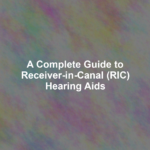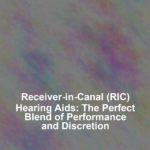As you navigate the nuanced necessities of nuanced hearing solutions, the Receiver-in-Canal (RIC) hearing aids emerge as a blend of comfort and cutting-edge technology.
YouG??ve likely pondered the pros and cons of various hearing aid styles, seeking a solution that doesnG??t just amplify sound but also fits seamlessly into your daily life. RIC devices distinguish themselves by housing the speaker directly in your ear canal, providing a natural listening experience with the bulk of the technology resting discreetly behind your ear.
If youG??re curious about how this innovative design can alleviate the common concerns associated with hearing aids, such as comfort during prolonged use or the stigma of visibility, consider this your invitation to explore the subtle yet significant advantages of RIC hearing aids.
What youG??ll find may not only change how you hear the world but also how comfortably you interact with it every day.
Understanding RIC Hearing Aids
Receiver-in-Canal (RIC) hearing aids incorporate a design where the speaker or receiver sits inside your ear canal, separated from the back of the device that rests discreetly behind your ear. This separation not only allows for a more natural sound experience but also reduces the size and visibility of the hearing aid, making it a popular choice for those concerned about aesthetics.
The main body of a RIC device houses the microphone and processor, which capture and process sound before sending it down a thin wire to the receiver in your ear. This design typically results in clearer audio with less feedback than traditional behind-the-ear (BTE) models. YouG??ll often find that RIC hearing aids are lightweight and comfortable, with many users forgetting theyG??re even wearing them after a short while.
Another advantage is that RIC aids can be easily adjusted to fit a wide range of hearing losses. TheyG??re versatile, allowing audiologists to fine-tune them to your specific needs. Plus, if your hearing changes, the receiver can often be replaced with a more powerful one without the need for a new hearing aid. This makes RIC a cost-effective and flexible solution for your hearing needs.
Key Benefits of RIC Devices
Building on their discrete design and clear sound quality, RIC hearing aids also offer several key benefits that cater to user comfort and convenience. YouG??ll find that the small size and lightweight nature of these aids allow you to wear them throughout the day without the bulkiness or discomfort that can come with other models. TheyG??re designed to fit neatly behind your ear, with only a thin wire and the tiny receiver sitting in your ear canal. This makes them less visible, boosting your confidence while engaging in social activities.
YouG??ll appreciate the ease of adjustment that RIC devices provide. The volume and settings can be modified without fuss, often with the touch of a button or remotely via a smartphone app. This means you can adapt to different listening environments effortlessly.
Moreover, the receiverG??s placement directly in the ear canal delivers sound more naturally and reduces the G??plugged upG?? sensation common with other hearing aid styles. The separation of the receiver from the main body of the hearing aid also reduces feedback, enhancing your listening experience.
How RIC Technology Works
To understand how RIC hearing aids enhance your auditory experience, itG??s essential to delve into the specifics of their technology. Unlike traditional hearing aids, RIC devices separate the speaker (receiver) from the main body of the hearing aid. This receiver is placed directly in your ear canal, connected to the body by a thin wire, allowing for a more natural sound quality and less distortion.
HereG??s a breakdown of RIC technology:
- Microphones: They pick up sounds from your environment, which are then processed by the hearing aid.
- Sound Processor: This component amplifies and clarifies the sound based on your specific hearing loss profile.
- Thin Wire: It transmits the processed sounds to the receiver, ensuring a discreet appearance and reducing the feeling of a plugged ear.
- Receiver: Placed in the ear canal, it delivers the final sound directly to your ear, providing a clear and high-fidelity auditory experience.
With this advanced design, youG??ll find that RIC hearing aids offer a level of sound quality and comfort that can truly transform the way you hear the world around you.
RIC Hearing Aids Fitting Process
When youG??re fitted for a RIC hearing aid, the process begins with a thorough assessment of your hearing needs to ensure the device is tailored specifically for you. An audiologist will conduct various tests to determine the nature and extent of your hearing loss. TheyG??ll also consider your lifestyle, preferences, and the physical shape of your ear canal.
After the evaluation, theyG??ll select a RIC hearing aid that best fits your requirements. YouG??ll receive guidance on how to insert and remove the device, along with tips for maintenance and cleaning. The audiologist will then program the hearing aid to match your hearing profile, optimizing it for different environments.
YouG??ll test the hearing aid in the clinic to make sure itG??s comfortable and provides the necessary amplification. ItG??s crucial to speak up if something doesnG??t feel right; the fit and sound can often be adjusted on the spot.
Maintaining Your RIC Device
Once youG??ve been fitted with a RIC hearing aid, itG??s essential to keep it in top condition through regular maintenance. Your daily routine should include some simple steps to ensure your device functions effectively and lasts longer. Remember, a well-maintained hearing aid can save you from unnecessary repairs or replacements.
HereG??s what you need to do:
- Clean it daily: Use a soft, dry cloth to gently clean the surface of your hearing aid. Be careful not to let water or other liquids come into contact with it.
- Check the receiver and microphone ports: Ensure thereG??s no buildup of earwax or debris that could block sound from coming through.
- Change filters and domes regularly: Follow the manufacturerG??s guidelines on how often to replace these parts to prevent damage and maintain sound quality.
- Keep it dry: Invest in a hearing aid dehumidifier to remove moisture that can accumulate and potentially damage the internal components.
DonG??t forget to schedule regular check-ups with your hearing care professional. TheyG??ll help you keep track of your deviceG??s condition and perform any necessary professional cleaning or adjustments. With proper care, your RIC hearing aid will keep you connected to the sounds you love.
Conclusion
YouG??ve explored the world of Receiver-In-Canal (RIC) hearing aids and discovered their unparalleled comfort. With their discreet design, clear sound quality, and easy maintenance, RIC devices offer a hearing solution that fits seamlessly into your life.
Embrace the technology that works effortlessly to enhance your hearing experience. Remember, taking care of your RIC device is simple, ensuring you enjoy the benefits of better hearing every day.
Welcome to the new standard in hearing aid comfort.











